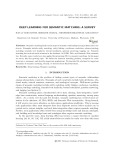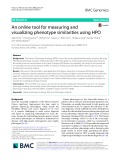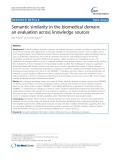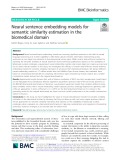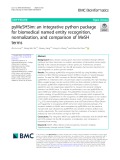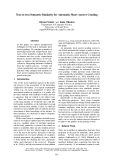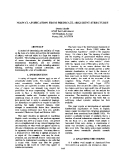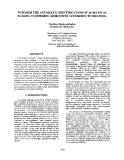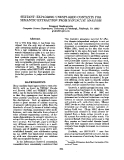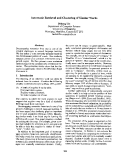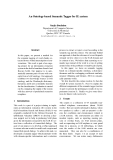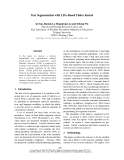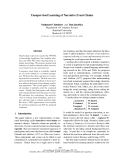
Semantic text similarity
-
Semantic matching has received much attention in the database, AI, KDD, Web, and Semantic Web communities. Recently, many works have also applied deep learning (DL) to semantic matching. In this paper we survey this fast growing topic. We define the semantic matching problem, categorize its variations into a taxonomy, and describe important applications. We describe DL solutions for important variations of semantic matching. Finally, we discuss future R&D directions.
 38p
38p  spiritedaway36
spiritedaway36
 25-11-2021
25-11-2021
 12
12
 0
0
 Download
Download
-
The Human Phenotype Ontology (HPO) is one of the most popular bioinformatics resources. Recently, HPO-based phenotype semantic similarity has been effectively applied to model patient phenotype data. However, the existing tools are revised based on the Gene Ontology (GO)-based term similarity. The design of the models are not optimized for the unique features of HPO. In addition, existing tools only allow HPO terms as input and only provide pure text-based outputs.
 9p
9p  vitzuyu2711
vitzuyu2711
 29-09-2021
29-09-2021
 19
19
 1
1
 Download
Download
-
Semantic similarity measures estimate the similarity between concepts, and play an important role in many text processing tasks. Approaches to semantic similarity in the biomedical domain can be roughly divided into knowledge based and distributional based methods.
 13p
13p  viwyoming2711
viwyoming2711
 16-12-2020
16-12-2020
 6
6
 1
1
 Download
Download
-
Neural network based embedding models are receiving significant attention in the field of natural language processing due to their capability to effectively capture semantic information representing words, sentences or even larger text elements in low-dimensional vector space.
 10p
10p  vijisoo2711
vijisoo2711
 27-10-2020
27-10-2020
 13
13
 1
1
 Download
Download
-
Biomedical literature concerns a wide range of concepts, requiring controlled vocabularies to maintain a consistent terminology across different research groups. However, as new concepts are introduced, biomedical literature is prone to ambiguity, specifically in fields that are advancing more rapidly, for example, drug design and development.
 12p
12p  vicolorado2711
vicolorado2711
 23-10-2020
23-10-2020
 12
12
 1
1
 Download
Download
-
Many disease causing genes have been identified through different methods, but there have been no uniform annotations of biomedical named entity (bio-NE) of the disease phenotypes of these genes yet. Furthermore, semantic similarity comparison between two bio-NE annotations has become important for data integration or system genetics analysis.
 14p
14p  vicolorado2711
vicolorado2711
 22-10-2020
22-10-2020
 10
10
 0
0
 Download
Download
-
Social media networks have evolved as a large repository of short documents and gives the greater challenges to effectively retrieve the content out of it. Many factors were involved in this process such as restricted length of a content, informal use of language (i.e., slangs, abbreviations, styles, etc.) and low contextualization of the user generated content. To meet out the above stated problems, latest studies on context-based information searching have been developed and built on adding semantics to the user generated content into the existing knowledge base.
 20p
20p  kequaidan1
kequaidan1
 05-11-2019
05-11-2019
 19
19
 2
2
 Download
Download
-
This approach is based on text snippets and page counts. These two measures are taken from the results of a search engine like Google. To achieve the aim of this paper, lexical patterns are extracted from text snippets and word co-occurrence measures are defined using page counts. The results of these two are combined.
 6p
6p  byphasse043256
byphasse043256
 24-03-2019
24-03-2019
 17
17
 0
0
 Download
Download
-
This paper proposes a method for measuring semantic similarity between words as a new tool for text analysis. The similarity is measured on a semantic network constructed systematically from a subset of the English dictionary, LDOCE (Long-man Dictionary of Contemporary English). Spreading activation on the network can directly compute the similarity between any two words in the Longman Defining Vocabulary, and indirectly the similarity of all the other words in LDOCE.
 8p
8p  buncha_1
buncha_1
 08-05-2013
08-05-2013
 51
51
 2
2
 Download
Download
-
In this paper, we explore unsupervised techniques for the task of automatic short answer grading. We compare a number of knowledge-based and corpus-based measures of text similarity, evaluate the effect of domain and size on the corpus-based measures, and also introduce a novel technique to improve the performance of the system by integrating automatic feedback from the student answers. Overall, our system significantly and consistently outperforms other unsupervised methods for short answer grading that have been proposed in the past. ...
 9p
9p  bunthai_1
bunthai_1
 06-05-2013
06-05-2013
 40
40
 2
2
 Download
Download
-
A method of determining the similarity of nouns on the basis of a metric derived from the distribution of subject, verb and object in a large text corpus is described. The resulting quasi-semantic classification of nouns demonstrates the plausibility of the distributional hypothesis, and has potential application to a variety of tasks, including automatic indexing, resolving nominal compounds, and determining the scope of modification. 1. I N T R O D U C T I O N A variety of linguistic relations apply to sets of semantically similar words. ...
 8p
8p  bungio_1
bungio_1
 03-05-2013
03-05-2013
 51
51
 1
1
 Download
Download
-
This paper proposes a new indicator of text structure, called the lexical cohesion profile (LCP), which locates segment boundaries in a text. A text segment is a coherent scene; the words in a segment a~e linked together via lexical cohesion relations. LCP records mutual similarity of words in a sequence of text. The similarity of words, which represents their cohesiveness, is computed using a semantic network. Comparison with the text segments marked by a number of subjects shows that LCP closely correlates with the human judgments.
 3p
3p  bunmoc_1
bunmoc_1
 20-04-2013
20-04-2013
 39
39
 3
3
 Download
Download
-
In this paper we present a method to group adjectives according to their meaning, as a first step towards the automatic identification of adjectival scales. We discuss the properties of adjectival scales and of groups of semantically related adjectives and how they imply sources of linguistic knowledge in text corpora. We describe how our system exploits this linguistic knowledge to compute a measure of similarity between two adjectives, using statistical techniques and without having access to any semantic information about the adjectives. ...
 11p
11p  bunmoc_1
bunmoc_1
 20-04-2013
20-04-2013
 56
56
 1
1
 Download
Download
-
For a very long time, it has been considered that the only way of automatically extracting similar groups of words from a text collection for which no semantic information exists is to use docum e n t co-occurrence data. But, with robust syntactic parsers that are becoming more frequently available, syntactically recognizable p h e n o m e n a about word usage can be confidently noted in large collections of texts.
 3p
3p  bunmoc_1
bunmoc_1
 20-04-2013
20-04-2013
 31
31
 1
1
 Download
Download
-
Bootstrapping semantics from text is one of the greatest challenges in natural language learning. We first define a word similarity measure based on the distributional pattern of words. The similarity measure allows us to construct a thesaurus using a parsed corpus. We then present a new evaluation methodology for the automatically constructed thesaurus. The evaluation results show that the thesaurns is significantly closer to WordNet than Roget Thesaurus is.
 7p
7p  bunrieu_1
bunrieu_1
 18-04-2013
18-04-2013
 46
46
 2
2
 Download
Download
-
In this paper, we present a method for the semantic tagging of word chunks extracted from a written transcription of conversations. This work is part of an ongoing project for an information extraction system in the field of maritime Search And Rescue (SAR). Our purpose is to automatically annotate parts of texts with concepts from a SAR ontology. Our approach combines two knowledge sources a SAR ontology and the Wordsmyth dictionarythesaurus, and it uses a similarity measure for the classification.
 8p
8p  bunbo_1
bunbo_1
 17-04-2013
17-04-2013
 39
39
 2
2
 Download
Download
-
In this paper we propose a domainindependent text segmentation method, which consists of three components. Latent Dirichlet allocation (LDA) is employed to compute words semantic distribution, and we measure semantic similarity by the Fisher kernel. Finally global best segmentation is achieved by dynamic programming. Experiments on Chinese data sets with the technique show it can be effective. Introducing latent semantic information, our algorithm is robust on irregular-sized segments.
 4p
4p  hongphan_1
hongphan_1
 15-04-2013
15-04-2013
 42
42
 2
2
 Download
Download
-
Hand-coded scripts were used in the 1970-80s as knowledge backbones that enabled inference and other NLP tasks requiring deep semantic knowledge. We propose unsupervised induction of similar schemata called narrative event chains from raw newswire text. A narrative event chain is a partially ordered set of events related by a common protagonist. We describe a three step process to learning narrative event chains. The first uses unsupervised distributional methods to learn narrative relations between events sharing coreferring arguments.
 9p
9p  hongphan_1
hongphan_1
 15-04-2013
15-04-2013
 53
53
 1
1
 Download
Download
-
In this paper, we present a unified model for the automatic induction of word senses from text, and the subsequent disambiguation of particular word instances using the automatically extracted sense inventory. The induction step and the disambiguation step are based on the same principle: words and contexts are mapped to a limited number of topical dimensions in a latent semantic word space.
 10p
10p  hongdo_1
hongdo_1
 12-04-2013
12-04-2013
 37
37
 2
2
 Download
Download
CHỦ ĐỀ BẠN MUỐN TÌM








